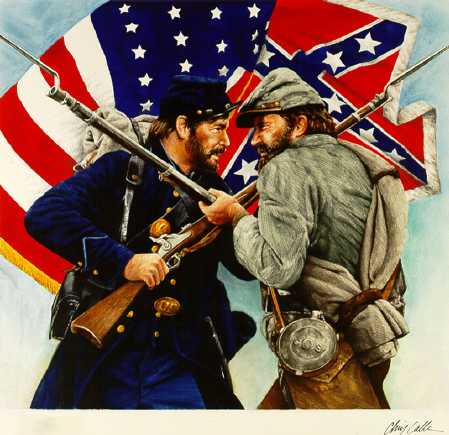 Winston Churchill once called the American Civil War the noblest and least avoidable of the great wars up to that time. The fact that the American Constitution nowhere dealt with the question of secession would make the war a subject of contention for generations.
Winston Churchill once called the American Civil War the noblest and least avoidable of the great wars up to that time. The fact that the American Constitution nowhere dealt with the question of secession would make the war a subject of contention for generations.
.
di John M. Taylor da ![]()
Now, a distinguished British historian, John Keegan — author of numerous books on warfare — has turned his attention to North America’s most studied conflict, our own Civil War. The result is a notably thoughtful, if occasionally controversial, discussion of how the North won.
Mr. Keegan brings to the war a detached foreign perspective. He is impressed with the geographic scope of the conflict, even though it encompassed no more than a third of present-day America. He notes the importance of rivers, writing, “The eastern rivers in Virginia … were chiefly valuable as water obstacles, most useful to a defender. In the West, the rivers were avenues of movement.”
He attributes the war’s ferocity in part to geography, “since the enemy’s personnel, in the absence of obvious geographic objectives, presented itself as the only target at which to strike.” This judgment is only partially correct, for the North and the South each worried constantly about the safety of its capital.
Mr. Keegan sees the war as a series of infantry clashes. “Neither side,” he writes, “fielded cavalry in sufficient numbers to perform the battle-winning role it had traditionally done in Europe.” Nor was artillery decisive, in part because many battles were fought in wooded areas that afforded limited visibility. Mr. Keegan is impressed with the number of battles that proved bloody but strategically indecisive.
Part of the explanation, he writes, is that as the war went on both sides — anticipating World War I — constructed earthworks “from which it was almost impossible to expel the enemy.” The bloody battle of Shiloh, the author writes, demonstrated to both sides that they were engaged in a war of attrition.
Mr. Keegan is at his best in discussing the opposing generals. “Stonewall” Jackson, he writes, succeeded because “he was utterly without fear or self-doubt.” George McClellan, in contrast, had a first-class military mind, yet “shrank from delivering decisive blows in battle.” His failures grew out of “his own defects of character.”
The author’s assessment of Robert E. Lee will not please the general’s many admirers. He correctly notes that Lee’s objective was “to win a great victory or series of victories that would dishearten his opponents and the North’s urban population.” And he concedes that Lee’s campaign of limited offensives into the North in 1862 and 1863 “is still a model of how a weaker power may bring pressure to bear on a stronger.” But he concludes that Lee’s strategic views were “rather narrow.” Had the South conserved its strength, Mr. Keegan writes, “the integrity of its heartland might have been preserved for longer than it was.”
Mr. Keegan is more focused on strategy than on tactics, so the reader in search of hour-by-hour descriptions of battles should look elsewhere. Even so, it is remarkable that the author discusses the Battle of Gettysburg without mentioning that Lee was without his cavalry for two of the three days of the battle, and therefore lacked accurate intelligence concerning his enemy. Grant, Mr. Keegan believes, was the greatest general to come out of the war. “He understood the war in its entirety, and quickly grasped how modern methods of communication, particularly the telegraph and the railroads,” had changed the nature of warfare. He won by taking risks, but the author concedes that “his soldiers paid the price.”
Mr. Keegan believes that the Civil War changed the nature of warfare forever. At the outset, Northern generals like Winfield Scott and McClellan had gone to great pains to avoid inflicting hardship on the South’s civilian population. That practice was to be changed by Grant and Sherman “when they began to destroy property and the [enemy’s] means of livelihood in their western campaigns.”
Mr. Keegan notes how the Civil War influenced future conflicts in Europe. Trench warfare in Virginia in 1864 anticipated the war of attrition along the Western Front in World War I. Sherman’s trashing of Georgia and the Carolinas presaged the area bombing of cities in World War II. The best single volume on the American Civil War remains James McPherson’s “Battle Cry of Freedom.” But Mr. Keegan’s fine book will find its way to many a bookshelf, especially those north of the Mason-Dixon line.

THE AMERICAN CIVIL WAR: A MILITARY HISTORY
By John Keegan
Knopf, $35, 376 pages, illus.
_________________________________
inserito su www.storiainrete.com l’11 novembre 2009


